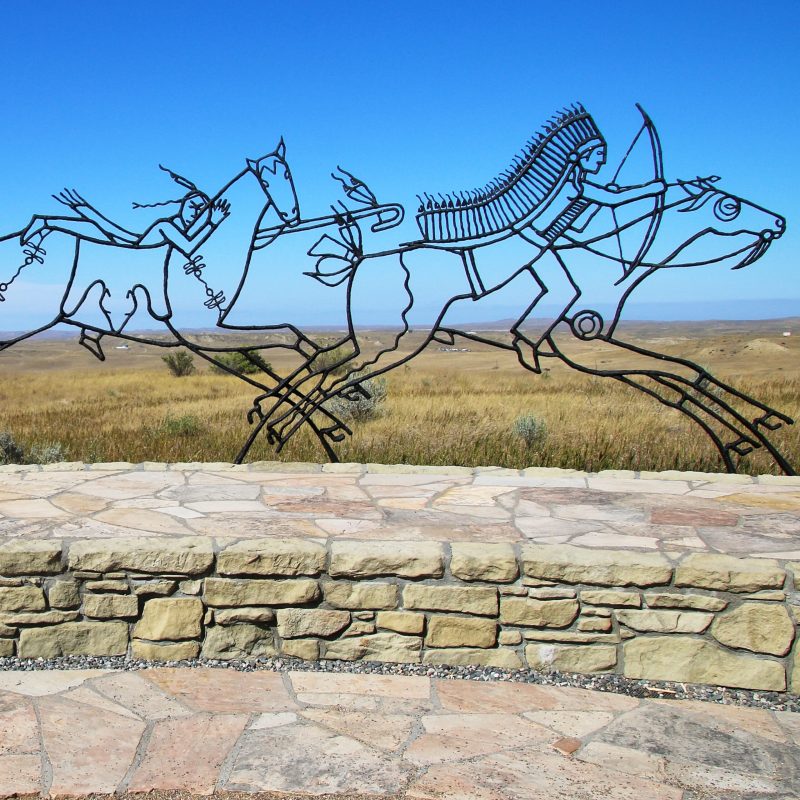
Although history books credit Christopher Columbus with discovering America after sailing the ocean blue in 1492, indigenous people had already been hunting bison, gathering fruit, weaving textiles, and living as one with the land for thousands of years.
Videos by TravelAwaits
Their lives were forever changed when the Nina, Pinta, and Santa Maria docked on this side of the Atlantic Ocean, connecting inhabitants from two very different continents — Europe and North America — for the first time.
Whether it’s Indigenous Peoples’ Day (an alternative to the federally recognized Columbus Day holiday), Native American Heritage Day (observed annually the day after Thanksgiving), or one of the other 363 days of the year, these seven places help you explore America’s Native American history.

1. National Museum Of The American Indian
Washington, D.C.
Located in the nation’s capital, the National Museum of the American Indian is one of the 17 museums that make up the Smithsonian Institution. The five-story, curved building on the southeastern portion of the National Mall was designed to look like natural rock shaped by the elements of wind and water over thousands of years. Inside and out, every aspect of the museum is intended to reinforce the oneness that the indigenous people of the Americas have with the planet.
With more than 800,000 objects and 125,000 photographs on display in galleries organized by geographic region, the National Museum of the American Indian shares the history and culture of a wide range of indigenous people from both North and South America. And when the museum was dedicated in September 2004, more than 20,000 Native Americans gathered for the event, making it the largest gathering of indigenous people in Washington, D.C., to date.
Native Americans manage the daily operations of the museum and work hard to ensure that visitors will experience something quite different from museums that focus on European and Euro-American culture when they visit. One delicious example is the Mitsitam Native Foods Cafe inside the museum. Instead of serving ham sandwiches and hot dogs, the cafe offers a seasonal, Native American-inspired menu, with dishes like wild salmon, bison, Indian fry bread tacos, and prickly pear mole.
2. National Museum Of The American Indian Heye Center
New York City, New York
Just east of Battery Park, where crowds of tourists line up daily to board the ferry to Liberty and Ellis islands, the Heye Center is a second Smithsonian property dedicated to the American Indian. It is located in the Alexander Hamilton U.S. Custom House, a Beaux-Arts historic landmark in downtown Manhattan.
One of the most notable exhibits at the Heye Center focuses on the sacrifices Native Americans have made in the armed forces. In part due to Windtalkers, the movie starring Nicholas Cage and Christian Slater, there’s been increased awareness of the role Navajo Indians played in World War II. But from the Revolutionary War to current conflicts in the Middle East, Native Americans have served in the military at a higher per capita rate than any other ethnic group. The National Museum of the American Indian Heye Center spotlights the contributions of indigenous peoples to our nation over the past several centuries.

3. Ancestral Puebloan Cliff Dwellings At Mesa Verde National Park
Southwestern Colorado
Built more than 800 years ago, the Cliff Palace was constructed by native Puebloans beginning in the late 12th century and is the largest cliff dwelling in America. Using sandstone, mortar, and wooden beams, the Pueblo people constructed an elaborate structure with 150 rooms. Used for ceremonies and gatherings, the Cliff Palace also has 23 kivas, a type of religious room associated with the kachina (or ancestral deification) beliefs of the Navajo and Hopi people.
If you’re feeling adventurous, take the one-hour Balcony House tour at Mesa Verde National Park. To explore this ancient ruin, you’ll have to climb a 32-foot ladder, squeeze through a narrow tunnel, and more. However, you will be treated to a very intimate look at a fascinating piece of America’s Native American heritage.
Pro Tip: Both Cliff Palace and Balcony House can only be visited via a ranger-led, guided-tour, so be sure to plan ahead to ensure you get a ticket.

4. Cahokia Mounds State Historic Site
Collinsville, Illinois
Nearly 1,000 years ago, directly across the Mississippi River from where the St. Louis Arch stands as a shining silver gate to the western half of the United States, was one of the largest and most sophisticated civilizations of its time. Now known as Cahokia after the indigenous people living in the area when French settlers first arrived in the 17th century, the society’s original name is unknown. But what we do know is that Cahokia’s population at its peak rivaled that of many European cities at the time — think Paris, London, and Berlin — with as many as 20,000 residents.
The most visible remains of this ancient society today are the Cahokia Mounds, and approximately 70 of the original 120 mounds are intact. These mounds were used for ceremonial and religious purposes, including burial. Covering 14 acres and rising to a height of 100 feet, Monk’s Mound is the largest Cahokia mound.
Another important relic is Woodhenge. By placing wooden posts in the ground at specific intervals, the Cahokia people used this timbered version of Stonehenge’s concept to mark the first day of each season. These dates were important to the Cahokia as their cultivation of the three sisters — corn, beans, and squash — allowed their community to support a larger population.
Fun Fact: Mesa Verde National Park and Cahokia Mounds State Historic Site are two of just 24 UNESCO World Heritage Sites in the U.S. These unique sites represent natural and cultural wonders and are part of an elite list of about 1,000 sites in more than 160 countries around the world.

5. Indian Pueblo Cultural Center
Albuquerque, New Mexico
New Mexico is home to 19 distinct pueblos, from Acoma to Zuni. And the Indian Pueblo Cultural Center in Albuquerque is dedicated to sharing the history, culture, and art of these indigenous people. The center’s primary permanent exhibit is titled “We are of This Place,” and it tells the story of the Pueblo people. Admire more than 2,500 artifacts including pottery, jewelry, baskets, and photographs.
The center also features more than 20 murals created by talented Pueblo artists. They detail their oneness with the earth as the planet rotates through the four seasons, from being thankful for plentiful rains to celebrating abundant harvests.
Rotating exhibits and special events round out the experience. It’s one thing to admire a mural of the Deer Dance, but it’s a whole other experience to witness a Deer Dance in real time.
Pro Tip: The Indian Pueblo Cultural Center is a Blue Star Museum. That means that they offer complimentary admission to active-duty military personnel and their families between Memorial Day and Labor Day.
6. Little Bighorn Battlefield
Horn County, Southern Montana
During the American Revolution against England, patriot Patrick Henry famously proclaimed, “Give me liberty, or give me death!” And his words always come to mind when I think of the Battle of Little Bighorn. About a century after Henry’s declaration, members of the Lakota and Cheyenne tribes joined forces in one of the last Native American attempts to protect their land and way of life from encroaching settlers and expansionists.
Remembering how this history lesson was taught back in elementary school, I recall a pro-European settler stance that deemed Lt. Col. George A. Custer a martyr who gave his life for manifest destiny. But the museum at this National Park Service site tells both sides of the story, sharing both the tragedy and the triumph. And gazing at the 7th Cavalry Monument and Indian Memorial where Native Americans and settlers fought to the death while a gentle breeze rustles through the prairie grass, it’s easy to remember that there really aren’t any winners during a war.
Pro Tip: After visiting Little Bighorn Battlefield, stop at the Custer Battlefield Trading Post to try some of the best Indian tacos in the country. A mixture of beans and seasoned ground bison is piled atop a circle of fry bread and finished with diced tomatoes, shredded lettuce, and sour cream.

7. Chief Crazy Horse Memorial
Custer County, South Dakota
The Black Hills of Custer County are probably most famous for Mount Rushmore. For it is here that the busts of George Washington, Thomas Jefferson, Teddy Roosevelt, and Abraham Lincoln have been chiseled into the side of a granite mountain. But about 15 miles down the road, another monumental sculpture stands pointing southeast, in the direction where many of Chief Crazy Horse’s people are buried.
Although it is far from completion, Chief Crazy Horse’s head is nearly 50 percent larger than any president carved into Mount Rushmore. And the Chief Crazy Horse Memorial won’t simply feature the head of the Indian leader who defeated Custer at the Battle of Little Bighorn. Rather, he’ll be galloping bare-chested out of the side of the mountain on a horse and will stand more than 560 feet tall, setting the world record for the largest mountain carving.
While it’s certainly massive, this memorial is also interesting for what it’s not, and that’s federally funded. Because the original visionaries for the memorial — Chief Henry Standing Bear and sculptor Korczak Ziolkowski — didn’t trust the federal government, they made a pact to fund the venture entirely through donations and admission fees. So the project, which began in 1946 and achieved a significant milestone in 1998 when the chief’s head was completed, has no estimated completion date.
As we explore our beautiful country from sea to shining sea, it is important to augment the version of history taught in many schools with other important facts about our past. And when it comes to honoring the people who lived on this continent for tens of thousands of years, these seven places will help you explore America’s Native American heritage.
Want to see more ancient indigenous art? Read up on where to see petroglyphs in the United States.
